Fishnet for an Atlas? You wonder about the title of the post - Does it make sense? By the end of the article, you will clearly understand why.
* Due to privacy issues, the name of the council and final output of this project are not shown
Problem
Recently, I was asked to print a massive (I mean massive) CAD file of all the roads and minor lanes for a council. I was given a PDF of the CAD file which had given me a context of the size of the map. This map (CAD file) is for field inspection of roads and it is full of annotation. If I were to print out from the PDF on A3 or even A0, a lot of the details (i.e. indicators) on the CAD files would remain obscure. We are talking about the high level of detail and we do realize the downside of CAD file - Text labels cannot be re-sized dynamically for different scales.First Attempted Solution
With this problem in mind, (from my past experience), data driven pages and mapbook approach of ArcGIS is the way to go to solve the problem. We need to segment this problem of printing of CAD file into couple of parts:
- Can the Drawing file (.dwg) imported straight into ArcGIS or QGIS?
- What is the scale of the map that it should be designed so that users can read the maps?(legibility)
- Does the CAD file has/ require a projection?
- How can I divide the council into a proper grid for data driven pages
As my computer does not have AUTOCAD, we need to address the first issue. Which software I should choose to view the CAD (.dwg) File. For ease of conversion, I opted for ArcGIS 10.3. Refer to this link for the process of conversion
Once the file was brought across, I exported selected number of useful element of CAD file into shapefiles. On the layout option of ArcGIS, I temporarily created a layout of the map and other map elements. Meantime, I found out that dwg. file had no projection. The council could not find the projection of the file. Hence, I temporarily projected into a projection that was suitable for the region.
However, looking back on the completed the projection, this print work may not require a projection in the first place.
As the work to design the map for print was unfolding, I felt the projection was required. This is because I will be using other projected datasets to be basis of the grid for Data Driven Pages. Hence, all the datasets including .dwg file.
I experimented with two scale levels for legibility test. One was 1:2000 and another was 1:5000
It was clear 1:5000 does not show the information the user needs on the field. Let's look at 1:2000 exampleAfter my supervisor agreed that 1:2000 scale was the way forward, now we reach the final question - How to divide the CAD file into multiple sheets?
My old (initial approach) was to find other freely available datasets which are suitable for large scale maps. After hours of experimenting with them and data driven pages, I wasn't satisfied. The scale of the map was either too large or too small.
Meantime, I made some moves to beautify the maps for the ease of reading. However, the question remains unanswered - how to divide the dwg. file into evenly spaced (with a good scale of 1:2000) for the entire region ?Creating Fishnet
I googled my answer and stumbled on GIS Stack Exchange, the answer I was seeking for. The commentator suggested that we should use Create Fishnet in ArcGIS. Please watch the video below to understand Fishnet.
Bingo! The answer I was looking for is ready for implementation. I did some initial experiments for some regions and found this is workable. Eventually, I implemented the Fishnet for the entire region (after couple of rounds of experimenting) and the grid I desired has emerged.
I placed the Grid into Data Driven Pages and it generated 135 maps at the scale of 1:2500 (which is good enough). I exported them into PDF and filtered many which are not useful sections for print.
Conclusion
Looking back, Create Fishnet approach eliminated the need for me to find other dataset to create customized grid. In my opinion, this approach works well when you don't have the desired dataset for the grid formation.
Hope all of you learned one new thing in ArcGIS!

